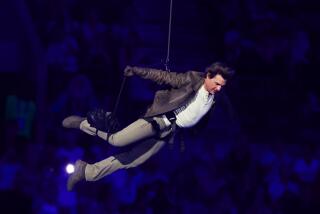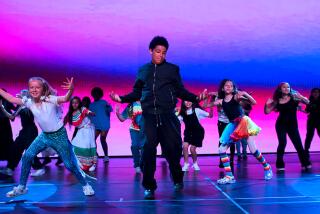WEEKEND REVIEWS : Dance : More Spectacle Than Edge in World Dance Finale
Attempts to bring a creative edge to the annual world dance finale of the Dance Kaleidoscope series are probably doomed. However, celebratory spectacle did occasionally yield to more purposeful expression at the John Anson Ford Amphitheatre on Saturday--never more memorably than when Mark Mendonca repeated the intense, sexy, technically dazzling untitled tap solo that had opened the series a week earlier.
Dance Theatre of East L.A. effectively undermined the traditional machismo of the event with âHombres,â Frank Guevaraâs forceful and often punishing study of male energy and instinctual competition (music by Kodo, the Japanese drum group). Strongly performed by Bogar Martinez and the choreographer, it boasted a promising new ending that fell victim to mistimed spotlight cues.
*
âClub Tumbao,â Kim Blankâs compilation of vibrant mambo, cha-cha and salsa dancing, fielded eight fine performers but lacked the ability to expand its source material to theatrical scale or sustain a consistent attitude toward the people depicted. Ricocheting between character parody and show-dance display, the piece ultimately looked tentative and locked down on the large outdoor stage.
Nothing tentative or locked down about Linda Vega, of course. But this flamboyant fixture of the local flamenco community lunged way, way over-the-top with âAlres del Puertoâ--starting with her gown (livid green with purple ruffles) and extending to a wildly grandiose performance style that only fitfully focused on actual dancing. Her excellent accompanists included Antonio Duran and Antonio de Triana on guitar.
The rest of the program showcased distinctive cultural traditions through dance suites so drastically edited that you scarcely had time to ooh and ah over one group of costumes before they were replaced by another. Senegal, Mindanao, Oaxaca--the dancers rushed in and out, well-coached and friendly, but never stopping you in your tracks, demanding your involvement, insisting on the primacy of any particular dance experience.
A kaleidoscope of cultures in itself, the Elk Whistle Native American Flute Ensemble came closest, perhaps, with Eric Running Pathâs Eagle Dance--a majestic soaring, swooping solo that managed to sensitively reflect the delicacy of Bill Nealâs flute accompaniment. Also on view: Kim Flying Eagleâs curiously nervous Hoop Dance.
The highly proficient Sona Sane West African Dance Ensemble emphasized four-man drumming and line dancing by nine women--very exciting before increasingly arbitrary changes in rhythm and pattern reminded you that someone in charge was more focused on the clock than the cultural imperatives of Senegal.
To taped music, Kultura Philippine Folk Arts crammed together four charming dances that ended, inevitably, with the Tinikling, in which couples stepped between and around horizontal bamboo poles that were rhythmically slammed together at floor level. But the suite didnât really end, it just stopped, and the question lingers: Why force four dances into the time allotted? Why not explore just one or two?
Enhanced by a versatile four-member percussion band, Kayamanan Ng Lahi Philippine Performing Arts presented colorful dances of the Bukidnon, Tagabilis and Bagobo peoples but generated a genuine impact only with a Higaonon Manobo dance drama about a predatory hawk (the imposing Michelle Papa) and the hunters stalking her.
Completing the program: Ballet Folklorico del Pacifico, having much more fun in its Oaxaca suite than it had a week earlier at Cal State L.A. Even its tinny taped music sounded better outdoors.
More to Read
The biggest entertainment stories
Get our big stories about Hollywood, film, television, music, arts, culture and more right in your inbox as soon as they publish.
You may occasionally receive promotional content from the Los Angeles Times.










